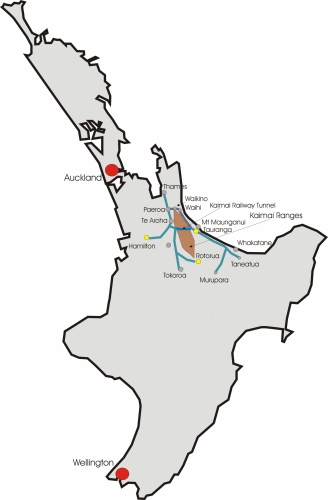|
Kaimai Deviation
The Kaimai Tunnel is a railway tunnel through the Kaimai Range in the North Island of New Zealand. Since it was opened in 1978, it has held the title of longest tunnel, at , in New Zealand, assuming this distinction from the previous title holder, the Rimutaka Tunnel. It is part of the Kaimai Deviation, which was constructed to bypass the old route of the East Coast Main Trunk Railway through the Karangahake Gorge (part of which has been preserved as the Goldfields Railway). History In the first half of the 20th century, the disadvantages of the East Coast Main Trunk route through the Karangahake and Athenree gorges became starkly apparent. The capacity of the line was constrained by several factors; its length, severe grades of up to 1:50, sharp curves of up to 6 chains radius, and light 55 lb per yard rail which prohibited the use of the more powerful diesel locomotives. It was also an unreliable route, with frequent disruptions caused by slips. Easing of the ruling grad ... [...More Info...] [...Related Items...] OR: [Wikipedia] [Google] [Baidu] |
East Coast Main Trunk Railway
The East Coast Main Trunk (ECMT) is a railway line in the North Island of New Zealand, originally running between Hamilton and Taneatua via Tauranga, connecting the Waikato with the Bay of Plenty. The ECMT now runs between Hamilton and Kawerau, with a branch line to Taneatua from the junction at Hawkens. The line is built to narrow gauge of , the uniform gauge in New Zealand. It was known as the East Coast Main Trunk Railway until 2011, when the word "Railway" was dropped. History Construction In 1880, the North Island Main Trunk railway had reached Frankton, Waikato, Frankton, Hamilton, New Zealand, Hamilton, from Auckland. From there, it was delayed by construction of the Claudelands Bridge, original Waikato River bridge (now carrying road traffic as part of Claudelands Road), before the line made its way to Morrinsville in October 1884, Te Aroha in March 1886 and Paeroa in 1898. There were also minor delays, such as in the delivery of Podocarpus totara, totara sleepers. The ... [...More Info...] [...Related Items...] OR: [Wikipedia] [Google] [Baidu] |
